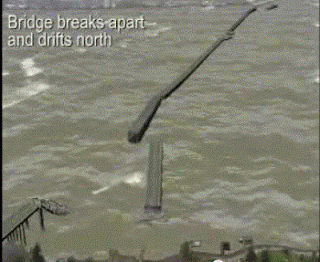The latest bridge collapse near Mt. Vernon is an exception to the rule, since weather did not play a role.
Galloping Gertie (Tacoma Narrows Bridge): November 7, 1940
Let's begin with perhaps the most famous of the bridge failures, the one shown in virtually every introductory physics class in the country: the Tacoma Narrows Bridge, also known affectionately as Galloping Gertie. ( Click on the picture below to see a video.) Gertie, located in a channel between the Kitsap Peninsula and Tacoma (see map), started gyrating and then collapsed on November 7, 1940.
Two hours later, the winds reached 42 miles per hour near the bridge's east end, and fishermen near the west end reported "substantially" stronger gusts. In the subsequent few hours the bridge started to oscillate or "gallop" and failed around 10:30 AM. Poor design, coupled with strong winds, destroyed this suspension bridge.
The Hood Canal Bridge: February 13, 1979
The most expensive local bridge failure was undoubtedly the Hood Canal Bridge, which failed during a freak windstorm, one in which gusts at the bridge reached well over 100 mph.
At first the origin of the winds was a great mystery. A strong Pacific cyclone was approaching the coast of central Vancouver Island (see figure). Forecasters expected winds of 30-40 mph over Puget Sound and nearby waters. But unexpectedly the winds accelerated to 100-130 mph over a very limited area around the Hood Canal Bridge. Massive tree falls occurred in the vicinity. After hours of pounding, a section of the bridge failed as the wind and wind driven waves struck the structure.
But why the huge winds? Professor Richard Reed of my department was hired to figure it out and did. By collecting every conventional and unconventional observation in the area he demonstrated that an intense mini-low pressure area formed near the bridge as a result of an unusual flow off the ocean interacting with the Olympic Mountains (sort of like an eddy in the lee of big rock in a stream--with the Olympics being a VERY big rock). Here is a pressure analysis produced by Professor Reed.
Strong winds were coming in off the Pacific and then they accelerated wildly to the north as they approached the low center (winds accelerate as air moves from high to low pressure).
The bridge was replaced at a cost of approximately $ 143 millions dollars.
The Old I90 Bridge: November 25, 1990
Heavy rain, rising lake levels, and open manhole covers contributed to the flooding of pontoons and the loss of the bridge, which was the world's first floating concrete pontoon bridge when it was dedicated in 1940. Another issue was that the pontoons were used to store contaminated demolition water. As the pontoons went down they also damaged cables for the new I90 bridge to its north.
Click on the picture below to watch it collapse!
http://www.youtube.com/watch?v=gm0YQ3vuyyY
The three weather-related bridge collapses may be the big ones, but weather related bridges incidents are legion around here. Major windstorms have damaged the cables holding the 520 bridge across Lake Washington in place. A truck was blown through the guard rails of the Biggs Bridge across the Columbia Gorge. The list is a long one. One thing is sure: Washington State bridges can be tested severely by local weather, flooding rivers, volcanic eruptions, and, of course, earthquakes. The current 520 bridge would be very vulnerable to a truly major storm, such as the 1962 Columbus Day Storm...fortunately it is being replaced. WSDOT did a simulation of what would happen with a storm with sustained 75 mph winds (about a once in 20-30 year event)--the current bridge would be history. Click on the picture below to see the scary results!
____________________________________________________________
Announcement: I will be teaching Atmospheric Sciences 101 (WEATHER) at the UW this fall. This class is accessible to folks 60 or older at very little cost (the UW Access Program) and, of course, to regular UW students. This class will give you a good basic understanding of the atmosphere and Northwest weather.










No comments:
Post a Comment